In Silico Comparative Genomic Analysis Revealed a Highly Conserved Proteolytic System in Lactobacillus delbrueckii
Abstract
1. Introduction
2. Results
2.1. Phylogenetic Analysis
2.2. In Silico Analysis of the Proteolytic System
2.2.1. Peptidases
2.2.2. Cell Envelope-Associated Proteinase (CEP)
2.2.3. Analysis of Promoter Regions and Putative Regulators
3. Discussion
4. Materials and Methods
4.1. Genome Selection
4.2. Average Nucleotide Identity (ANI) Analysis
4.3. Multilocus Sequence Analysis (MLSA) and Pangenomic Analysis
4.4. In Silico Analysis of Promoter Region and Predicted Amino Acid Sequence of prt Genes
4.5. Protein Modeling and Visualization
5. Conclusions
Supplementary Materials
Author Contributions
Funding
Institutional Review Board Statement
Informed Consent Statement
Data Availability Statement
Conflicts of Interest
References
- Adimpong, D.B.; Nielsen, D.S.; Sørensen, K.I.; Vogensen, F.K.; Sawadogo-Lingani, H.; Derkx, P.M.F.; Jespersen, L. Lactobacillus delbrueckii subsp. jakobsenii subsp. nov., isolated from dolo wort, an alcoholic fermented beverage in Burkina Faso. Int. J. Syst. Evol. Microbiol. 2013, 63, 3720–3726. [Google Scholar] [CrossRef]
- Zheng, J.; Wittouck, S.; Salvetti, E.; Franz, C.M.A.P.; Harris, H.M.B.; Mattarelli, P.; O’Toole, P.W.; Pot, B.; Vandamme, P.; Walter, J.; et al. A taxonomic note on the genus Lactobacillus: Description of 23 novel genera, emended description of the genus Lactobacillus Beijerinck 1901, and union of Lactobacillaceae and Leuconostocaceae. Int. J. Syst. Evol. Microbiol. 2020, 70, 2782–2858. [Google Scholar] [CrossRef]
- Espeche Turbay, M.B.; De Giori, G.S.; Hebert, E.M. Release of the Cell-Envelope-Associated Proteinase of Lactobacillus delbrueckii Subspecies lactis CRL 581 Is Dependent upon pH and Temperature. J. Agric. Food Chem. 2009, 57, 8607–8611. [Google Scholar] [CrossRef] [PubMed]
- Elean, M.; Albarracín, L.; Cataldo, P.; Londero, A.; Kitazawa, H.; Saavedra, L.; Villena, J.; Hebert, E. New immunobiotics from highly proteolytic Lactobacillus delbrueckii strains: Their impact on intestinal antiviral innate immune response. Benef. Microbes 2020, 11, 375–390. [Google Scholar] [CrossRef]
- Hebert, E.M.; Raya, R.R.; de Giori, G.S. Nutritional requirements of Lactobacillus delbrueckii subsp. lactis in a chemically defined medium. Curr. Microbiol. 2004, 49, 341–345. [Google Scholar] [CrossRef] [PubMed]
- Hebert, E.M.; De Giori, G.S.; Raya, R.R. Isolation and Characterization of a Slowly Milk-Coagulating Variant of Lactobacillus helveticus Deficient in Purine Biosynthesis. Appl. Environ. Microbiol. 2001, 67, 1846–1850. [Google Scholar] [CrossRef] [PubMed]
- Brown, L.; Villegas, J.M.; Elean, M.; Fadda, S.; Mozzi, F.; Saavedra, L.; Hebert, E.M. YebC, a putative transcriptional factor involved in the regulation of the proteolytic system of Lactobacillus. Sci. Rep. 2017, 7, 8579. [Google Scholar] [CrossRef]
- Saavedra, L.; Hebert, E.M.; Minahk, C.; Ferranti, P. An overview of “omic” analytical methods applied in bioactive peptide studies. Food Res. Int. 2013, 54, 925–934. [Google Scholar] [CrossRef]
- Hebert, E.M.; Mamone, G.; Picariello, G.; Raya Raúl, R.; Savoy, G.; Ferranti, P.; Addeo, F. Characterization of the Pattern of αs1- and β-Casein Breakdown and Release of a Bioactive Peptide by a Cell Envelope Proteinase from Lactobacillus delbrueckii subsp. lactis CRL 581. Appl. Environ. Microbiol. 2008, 74, 3682–3689. [Google Scholar] [CrossRef]
- Ji, D.; Ma, J.; Xu, M.; Agyei, D. Cell-envelope proteinases from lactic acid bacteria: Biochemical features and biotechnological applications. Compr. Rev. Food Sci. Food Saf. 2021, 20, 369–400. [Google Scholar] [CrossRef]
- Liu, M.; Bayjanov, J.R.; Renckens, B.; Nauta, A.; Siezen, R.J. The proteolytic system of lactic acid bacteria revisited: A genomic comparison. BMC Genom. 2010, 11, 36. [Google Scholar] [CrossRef] [PubMed]
- Huang, C.; Kok, J. Editing of the Proteolytic System of Lactococcus lactis Increases Its Bioactive Potential. Appl. Environ. Microbiol. 2020, 86, e01319-20. [Google Scholar] [CrossRef]
- Hebert, E.M.; Raya, R.R.; Brown, L.; de Valdez, G.F.; de Giori, G.S.; Taranto, M.P. Genome Sequence of the Cheese-Starter Strain Lactobacillus delbrueckii subsp. lactis CRL 581. Genome Announc. 2013, 1, e00602-13. [Google Scholar] [CrossRef] [PubMed]
- Kanmani, P.; Albarracin, L.; Kobayashi, H.; Hebert, E.M.; Saavedra, L.; Komatsu, R.; Gatica, B.; Miyazaki, A.; Ikeda-Ohtsubo, W.; Suda, Y.; et al. Genomic Characterization of Lactobacillus delbrueckii TUA4408L and Evaluation of the Antiviral Activities of its Extracellular Polysaccharides in Porcine Intestinal Epithelial Cells. Front. Immunol. 2018, 9, 2178. [Google Scholar] [CrossRef] [PubMed]
- Richter, M.; Rossello-Mora, R. Shifting the genomic gold standard for the prokaryotic species definition. Proc. Natl. Acad. Sci. USA 2009, 106, 19126–19131. [Google Scholar] [CrossRef]
- Kim, M.; Oh, H.-S.; Park, S.-C.; Chun, J. Towards a taxonomic coherence between average nucleotide identity and 16S rRNA gene sequence similarity for species demarcation of prokaryotes. Int. J. Syst. Evol. Microbiol. 2014, 64, 346–351. [Google Scholar] [CrossRef]
- Villegas, J.M.; Brown, L.; De Giori, G.S.; Hebert, E.M. Characterization of the mature cell surface proteinase of Lactobacillus delbrueckii subsp. lactis CRL 581. Appl. Microbiol. Biotechnol. 2014, 99, 4277–4286. [Google Scholar] [CrossRef]
- Ittisoponpisan, S.; Islam, S.A.; Khanna, T.; Alhuzimi, E.; David, A.; Sternberg, M.J. Can Predicted Protein 3D Structures Provide Reliable Insights into whether Missense Variants Are Disease Associated? J. Mol. Biol. 2019, 431, 2197–2212. [Google Scholar] [CrossRef]
- Ravin, V.; Alatossava, T. A new insertion sequence element, ISLdl1, in Lactobacillus delbrueckii subsp. lactis ATCC 15808. Microbiol. Res. 2002, 157, 109–114. [Google Scholar] [CrossRef]
- Bruton, C.J.; Chater, K.F. Nucleotide sequence of IS110, an insertion sequence of Streptomyces coelicolor A3(2). Nucleic. Acids. Res. 1987, 15, 7053–7065. [Google Scholar] [CrossRef]
- Decker, K.B.; Hinton, D.M. Transcription regulation at the core: Similarities among bacterial, archaeal, and eukaryotic RNA polymerases. Annu. Rev. Microbiol. 2013, 67, 113–139. [Google Scholar] [CrossRef]
- Ross, W.; Gosink, K.K.; Salomon, J.; Igarashi, K.; Zou, C.; Ishihama, A.; Severinov, K.; Gourse, R.L. A third recognition element in bacterial promoters: DNA binding by the alpha subunit of RNA polymerase. Science 1993, 262, 1407–1413. [Google Scholar] [CrossRef] [PubMed]
- Gilbert, C.; Atlan, D.; Blanc, B.; Portailer, R.; Germond, J.E.; Lapierre, L.; Mollet, B. A new cell surface proteinase: Sequencing and analysis of the prtB gene from Lactobacillus delbruekii subsp. bulgaricus. J. Bacteriol. 1996, 178, 3059–3065. [Google Scholar] [CrossRef] [PubMed]
- Kieliszek, M.; Pobiega, K.; Piwowarek, K.; Kot, A.M. Characteristics of the Proteolytic Enzymes Produced by Lactic Acid Bacteria. Molecules 2021, 26, 1858. [Google Scholar] [CrossRef] [PubMed]
- Wakai, T.; Yamamoto, N. A novel branched chain amino acids responsive transcriptional regulator, BCARR, negatively acts on the proteolytic system in Lactobacillus helveticus. PLoS ONE 2013, 8, e75976. [Google Scholar] [CrossRef]
- Alcantara, C.; Bauerl, C.; Revilla-Guarinos, A.; Perez-Martinez, G.; Monedero, V.; Zuniga, M. Peptide and amino acid metabolism is controlled by an OmpR-family response regulator in Lactobacillus casei. Mol. Microbiol. 2016, 100, 25–41. [Google Scholar] [CrossRef]
- Sayers, E.W.; Bolton, E.E.; Brister, J.R.; Canese, K.; Chan, J.; Comeau, D.C.; Connor, R.; Funk, K.; Kelly, C.; Kim, S.; et al. Database resources of the national center for biotechnology information. Nucleic Acids Res. 2022, 50, D20–D26. [Google Scholar] [CrossRef]
- Richter, M.; Rossello-Mora, R.; Oliver Glockner, F.; Peplies, J. JSpeciesWS: A web server for prokaryotic species circumscription based on pairwise genome comparison. Bioinformatics 2016, 32, 929–931. [Google Scholar] [CrossRef]
- Tatusova, T.; DiCuccio, M.; Badretdin, A.; Chetvernin, V.; Nawrocki, E.P.; Zaslavsky, L.; Lomsadze, A.; Pruitt, K.D.; Borodovsky, M.; Ostell, J. NCBI prokaryotic genome annotation pipeline. Nucleic Acids Res. 2016, 44, 6614–6624. [Google Scholar] [CrossRef]
- Emms, D.M.; Kelly, S. OrthoFinder: Phylogenetic orthology inference for comparative genomics. Genome Biol. 2019, 20, 238. [Google Scholar] [CrossRef]
- Song, Y.; Sun, Z.; Guo, C.; Wu, Y.; Liu, W.; Yu, J.; Menghe, B.; Yang, R.; Zhang, H. Genetic diversity and population structure of Lactobacillus delbrueckii subspecies bulgaricus isolated from naturally fermented dairy foods. Sci. Rep. 2016, 6, 22704. [Google Scholar] [CrossRef]
- Edgar, R.C. MUSCLE: Multiple sequence alignment with high accuracy and high throughput. Nucleic Acids Res. 2004, 32, 1792–1797. [Google Scholar] [CrossRef] [PubMed]
- Sigworth, F.J.; Doerschuk, P.C.; Carazo, J.M.; Scheres, S.H. An introduction to maximum-likelihood methods in cryo-EM. Methods Enzym. 2010, 482, 263–294. [Google Scholar] [CrossRef]
- Kumar, S.; Stecher, G.; Li, M.; Knyaz, C.; Tamura, K. MEGA X: Molecular Evolutionary Genetics Analysis across Computing Platforms. Mol. Biol. Evol. 2018, 35, 1547–1549. [Google Scholar] [CrossRef]
- Aziz, R.K.; Bartels, D.; Best, A.A.; DeJongh, M.; Disz, T.; Edwards, R.A.; Formsma, K.; Gerdes, S.; Glass, E.M.; Kubal, M.; et al. The RAST Server: Rapid annotations using subsystems technology. BMC Genom. 2008, 9, 75. [Google Scholar] [CrossRef] [PubMed]
- Di Tommaso, P.; Moretti, S.; Xenarios, I.; Orobitg, M.; Montanyola, A.; Chang, J.-M.; Taly, J.-F.; Notredame, C. T-Coffee: A web server for the multiple sequence alignment of protein and RNA sequences using structural information and homology extension. Nucleic Acids Res. 2011, 39, W13–W17. [Google Scholar] [CrossRef]
- Crooks, G.E.; Hon, G.; Chandonia, J.-M.; Brenner, S.E. WebLogo: A Sequence Logo Generator. Genome Res. 2004, 14, 1188–1190. [Google Scholar] [CrossRef]
- Sullivan, M.J.; Petty, N.K.; Beatson, S.A. Easyfig: A genome comparison visualizer. Bioinformatics 2011, 27, 1009–1010. [Google Scholar] [CrossRef]
- Kelley, L.A.; Mezulis, S.; Yates, C.M.; Wass, M.N.; Sternberg, M.J. The Phyre2 web portal for protein modeling, prediction and analysis. Nat. Protoc. 2015, 10, 845–858. [Google Scholar] [CrossRef]
- Reynolds, C.R.; Islam, S.A.; Sternberg, M.J.E. EzMol: A Web Server Wizard for the Rapid Visualization and Image Production of Protein and Nucleic Acid Structures. J. Mol. Biol. 2018, 430, 2244–2248. [Google Scholar] [CrossRef]
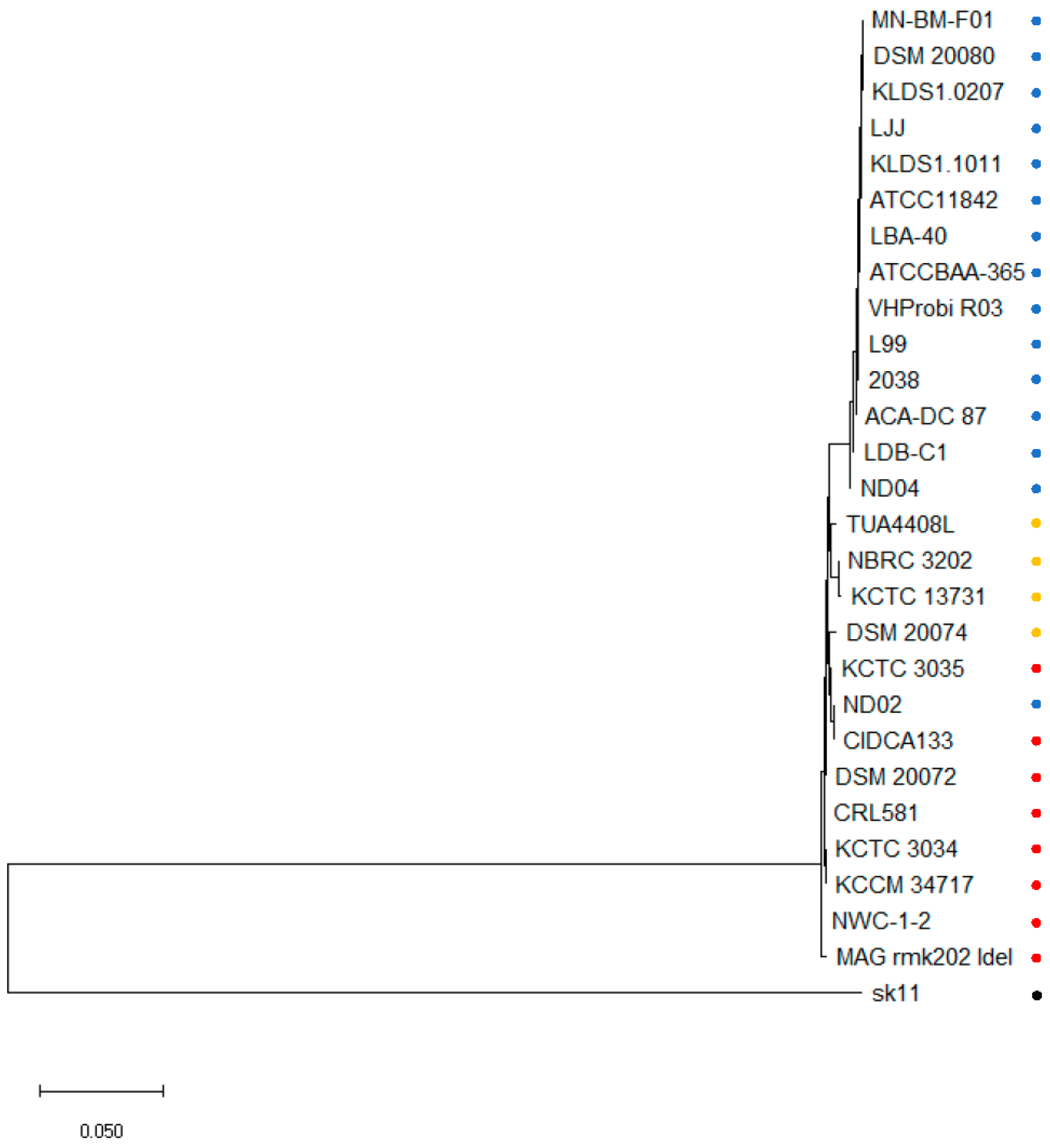
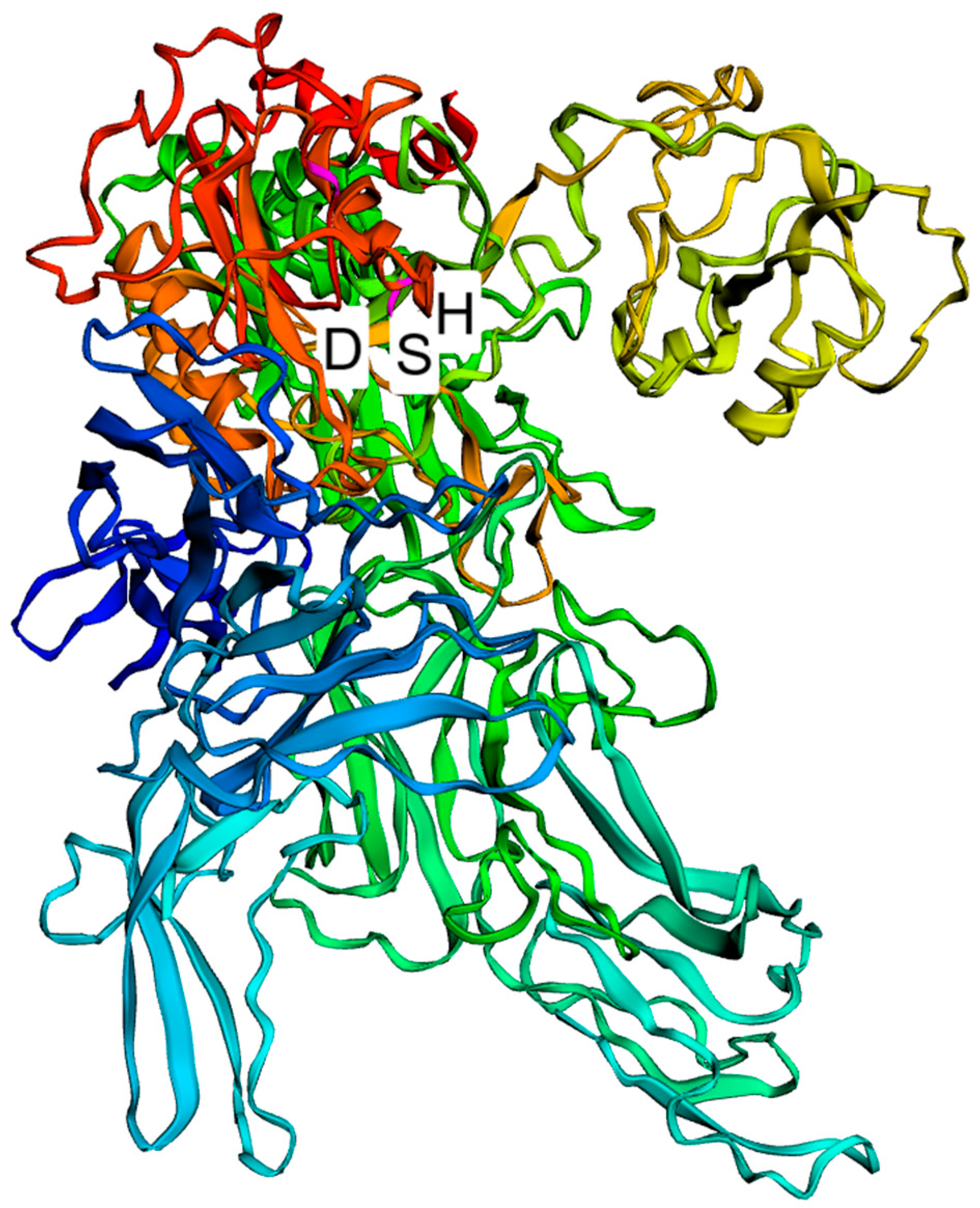
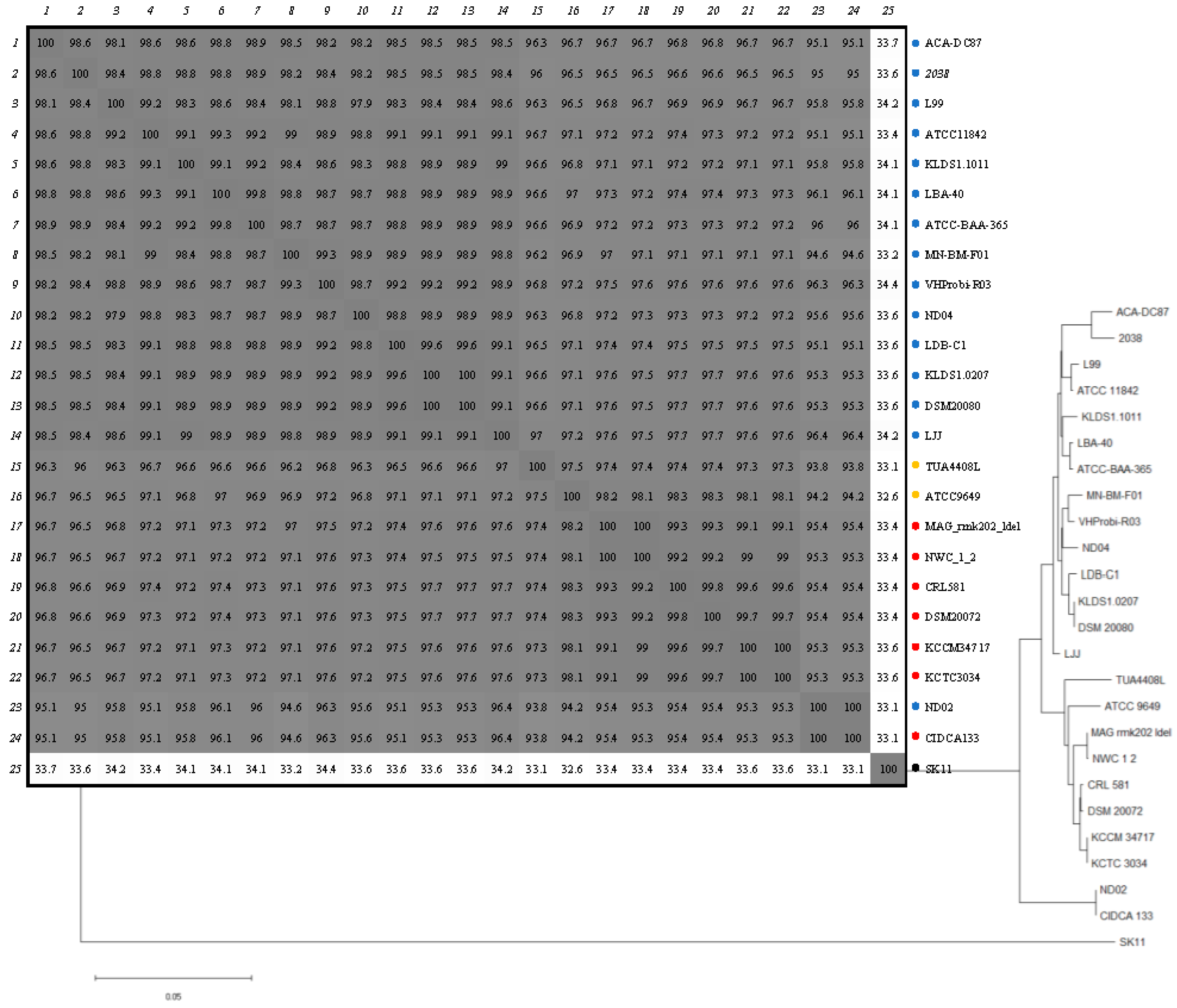
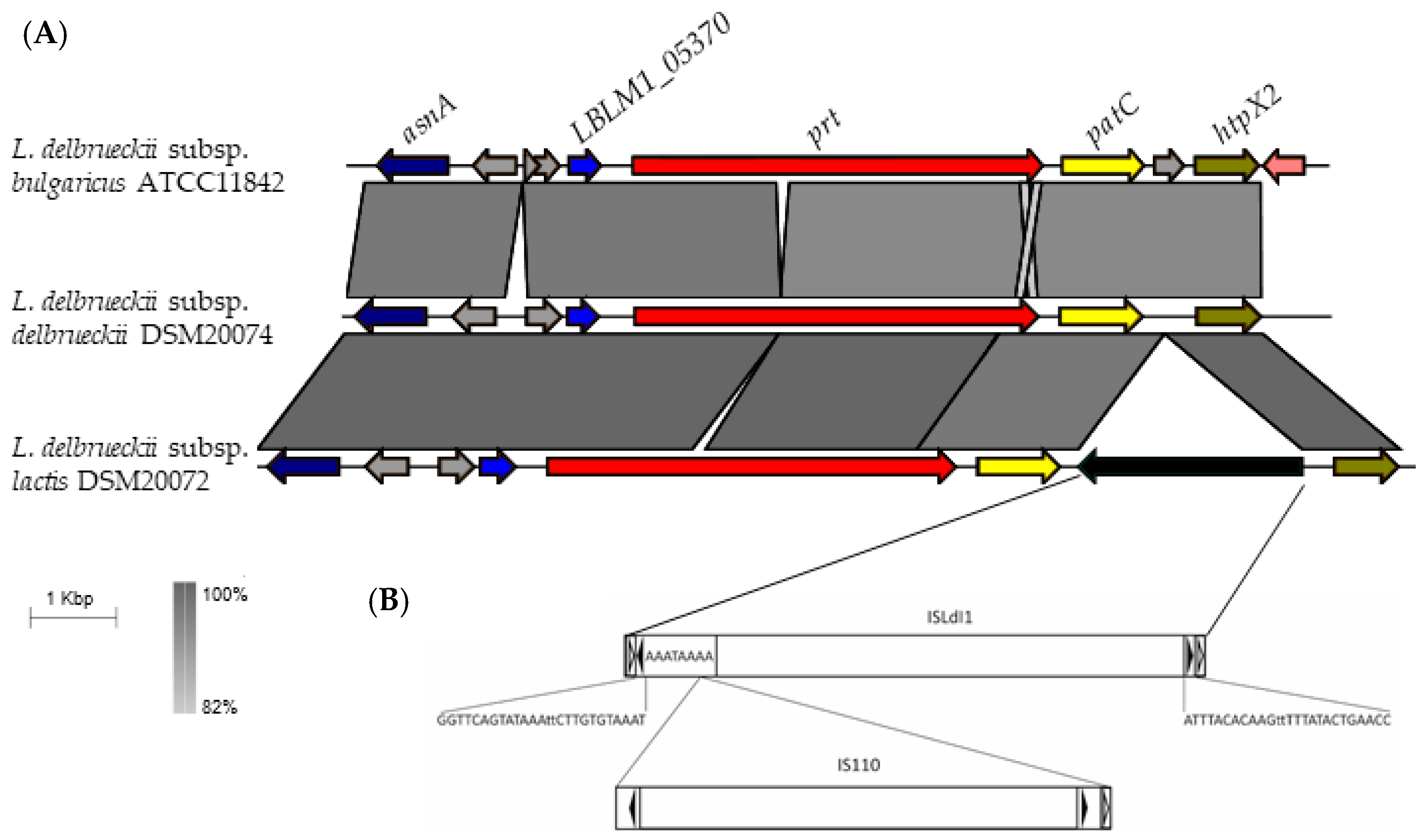

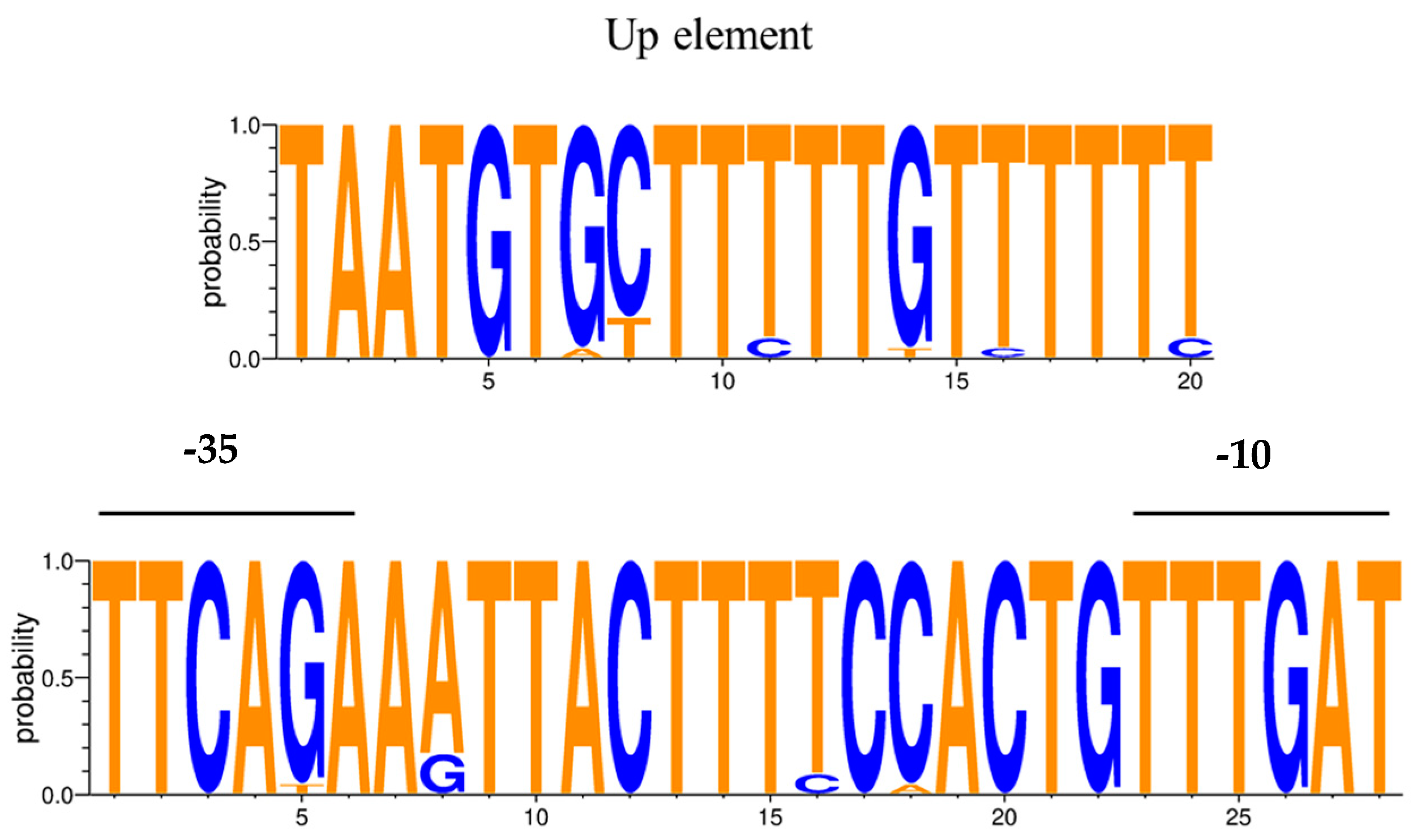
| Peptidase | Orthogroup | MEROPS Family | Gene (Locus) in CRL 581 | Pangenome analysis |
|---|---|---|---|---|
| Aminopeptidases | 4 | |||
| Aminopeptidase C | OG0000892 | C1 | pepC (G134_RS08320) | Core-genome |
| Lysine aminopeptidase | OG0000959 | M1 | pepN (G134_RS03335) | Core-genome |
| Glutamine aminopeptidase | OG0000394 | M42 | pepA (G134_RS00305) | Softcore-genome |
| Methionine aminopeptidase | OG0000412 | M24A | pepM (G134_RS00100) | Core-genome |
| Endopeptidases | ||||
| Oligopeptidase F | OG0000936 | M3 | pepF (G134_RS03600) | Core-genome |
| Oligopeptidase O | OG0000119 | M13 | pepO (G134_RS01630) | Core-genome |
| Peptidase G | OG0001037 | C1 | pepG/E (G134_RS01440) | Softcore-genome |
| Dipeptidases | ||||
| Dipeptidase A | OG0000081 | C69 | pepD (G134_RS03315) | Core-genome |
| Dipeptidase V | OG0000164 | M20A | pepV (G134_RS08405) | Core-genome |
| Tripeptidases | ||||
| Tripeptidase T | OG0000320 | M20B | pepT (G134_RS01035) | Core-genome |
| Prolyl peptidases | ||||
| Aminopeptidase P | OG0001207 | M24B | pepP (G134_RS05655) | Softcore-genome |
| Prolidase | OG0000832 | M24B | pepQ (G134_RS07685) | Core-genome |
| X-Prolyl-dipeptidyl aminopeptidase | OG0000775 | S15 | pepX (G134_RS05545) | Core-genome |
| Proline dipeptidase | OG0000913 | S33 | pepR (G134_RS08875) | Core-genome |
| Proline aminopeptidase | OG0001790 | S33 | pepL (G134_RS06955) | Shell-genome |
| Proline aminopeptidase | OG0000907 | S33 | pepI (G134_RS08815) | Core-genome |
| Strain | UP Element | b 1 | Element-35 | a 2 | Element-10 |
|---|---|---|---|---|---|
| L. delbrueckii subsp. bulgaricus NCDO1489 | TAATGTGCTTTTTGTTTTTT | 4 | TTCAGA | 16 | TTTGAT |
| L. delbrueckii subsp. bulgaricus 2038 | TAATGTGCTTTTTGTTTTTT | 4 | TTCAGA | 16 | TTTGAT |
| L. delbrueckii subsp. bulgaricus ACA-DC 87 | TAATGTGCTTTTTGTTTTTT | 4 | TTCAGA | 16 | TTTGAT |
| L. delbrueckii subsp. bulgaricus ATCC-BAA365 | TAATGTGCTTTTTGTTTTTT | 4 | TTCAGA | 16 | TTTGAT |
| L. delbrueckii subsp. bulgaricus ATCC 11842 | TAATGTGCTTTTTGTTTTTT | 4 | TTCAGA | 16 | TTTGAT |
| L. delbrueckii subsp. bulgaricus DSM 20080 | TAATGTGCTTTTTGTTTTTT | 4 | TTCAGA | 16 | TTTGAT |
| L. delbrueckii subsp. bulgaricus KLDS 1.0207 | TAATGTGCTTTTTGTTTTTT | 4 | TTCAGA | 16 | TTTGAT |
| L. delbrueckii subsp. bulgaricus KLDS 1.1011 | TAATGTGCTTTTTGTTTTTT | 4 | TTCAGA | 16 | TTTGAT |
| L. delbrueckii subsp. bulgaricus LBA-40 | TAATGTGCTTTTTGTTTTTT | 4 | TTCAGA | 16 | TTTGAT |
| L. delbrueckii subsp. bulgaricus LDB-CI | TAATGTGCTTTTTGTTTTTT | 4 | TTCAGA | 16 | TTTGAT |
| L. delbrueckii subsp. bulgaricus LJJ | TAATGTGCTTTTTGTTTTTT | 4 | TTCAGA | 16 | TTTGAT |
| L. delbrueckii subsp. bulgaricus L99 | TAATGTGCTTTTTGTTTTTT | 4 | TTCAGA | 16 | TTTGAT |
| L. delbrueckii subsp. bulgaricus MN-BM-F01 | TAATGTGCTTTTTGTTTTTT | 5 | TTCAGA | 16 | TTTGAT |
| L. delbrueckii subsp. bulgaricus ND04 | TAATGTGCTTTTTGTTTTTT | 4 | TTCAGA | 16 | TTTGAT |
| L. delbrueckii subsp. bulgaricus VHProbi R03 | TAATGTGCTTTTTGTTTTTT | 5 | TTCAGA | 16 | TTTGAT |
| L. delbrueckii subsp. delbrueckii ATCC 9649 | TAATGTGCTTTTTGTTTTTT | 4 | TTCATA | 16 | TTTGAT |
| L. delbrueckii subsp. delbrueckii TUA4408L | TAATGTACTTTTTGTCTTTT | 4 | TTCAGA | 16 | TTTGAT |
| L. delbrueckii subsp. lactis CRL 581 | TAATGTGTTTTTTGTTTTTT | 4 | TTCAGA | 16 | TTTGAT |
| L. delbrueckii subsp. lactis CIDCA133 | TAATGTGCTTCTTGTTTTTC | 4 | TTCAGA | 16 | TTTGAT |
| L. delbrueckii subsp. lactis DSM 20072 | TAATGTGTTTTTTTTTTTTT | 6 | TTCAGA | 16 | TTTGAT |
| L. delbrueckii subsp. lactis MAG_rmk202_ldel | TAATGTGTTTTTTGTTTTTT | 4 | TTCAGA | 16 | TTTGAT |
| L. delbrueckii subsp. lactis NWC-1-2 | TAATGTGTTTTTTGTTTTTT | 4 | TTCAGA | 16 | TTTGAT |
| L. delbrueckii ND02 | TAATGTGCTTCTTGTTTTTC | 4 | TTCAGA | 16 | TTTGAT |
| Strain | Species | G + C% | Access | Chromosome | Plasmid |
|---|---|---|---|---|---|
| 2038 | L. delbrueckii subsp. bulgaricus | 49.7 | GCA_000191165.1 | CP000156.1 | |
| ACA-DC-87 | L. delbrueckii subsp. bulgaricus | 49.8 | GCA_900196735.1 | NZ_LT899687.1/LT899687.1 | |
| ATCC 11842 (DSM 20081) | L. delbrueckii subsp. bulgaricus | 49.7 | GCA_000056065.1 | NC_008054.1/CR954253.1 | |
| ATCC BAA-365 | L. delbrueckii subsp. bulgaricus | 49.7 | GCA_000014405.1 | NC_008529.1/CP000412.1 | |
| DSM 20080 | L. delbrueckii subsp. bulgaricus | 49.8 | GCA_001953135.1 | NZ_CP019120.1/CP019120.1 | |
| KLDS 1.0207 | L. delbrueckii subsp. bulgaricus | 49.8 | GCA_003597655.1 | NZ_CP032451.1/CP032451.1 | |
| KLDS 1.1011 | L. delbrueckii subsp. bulgaricus | 49.8 | GCA_006704185.1 | NZ_CP041280.1/CP041280.1 | |
| LBA-40 | L. delbrueckii subsp. bulgaricus | 49.9 | GCA_024665995.1 | NZ_CP102529.1/CP102529.1 | |
| LDB-C1 | L. delbrueckii subsp. bulgaricus | 50.0 | GCA_023205755.1 | NZ_CP050929.1/CP050929.1 | |
| L99 | L. delbrueckii subsp. bulgaricus | 49.7 | GCA_003351805.1 | NZ_CP017235.1/CP017235.1 | |
| LJJ | L. delbrueckii subsp. bulgaricus | 49.5 | GCA_011044195.1 | NZ_CP049052.1/CP049052.1 | |
| MN-BM-F01 | L. delbrueckii subsp. bulgaricus | 49.7 | GCA_001469775.1 | NZ_CP013610.1/CP013610.1 | |
| ND02 | L. delbrueckii subsp. bulgaricus | 49.6 | GCA_000182835.1 | NC_014727.1/CP002341.1 | NC_014728.1/CP002342.1 |
| ND04 | L. delbrueckii subsp. bulgaricus | 49.6 | GCA_002000885.1 | NZ_CP016393.1/CP016393.1 | |
| VHProbi R03 | L. delbrueckii subsp. bulgaricus | 49.7 | GCA_023204995.1 | NZ_CP096210.1/CP096210.1 | |
| DSM 20074 (ATCC 9649) | L. delbrueckii subsp. delbrueckii | 49.6 | GCA_001908495.1 | NZ_CP018615.1/CP018615.1 | |
| KCTC 13731 | L. delbrueckii subsp. delbrueckii | 50.0 | GCA_001888945.1 | NZ_CP018216.1/CP018216.1 | |
| NBRC 3202 | L. delbrueckii subsp. delbrueckii | 50.1 | GCA_006740305.1 | NZ_AP019750.1/AP019750.1 | |
| TUA4408L | L. delbrueckii subsp. delbrueckii | 49.9 | GCA_002142575.1 | NZ_CP021136.1/CP021136.1 | |
| JCM 15610 | L. delbrueckii subsp. indicus | 49.4 | GCA_001908415.1 | NZ_CP018614.1/CP018614.1 | pLD01: NZ_CP018612.1/CP018612.1pLD02: NZ_CP018613.1/CP018613.1 |
| CIDCA133 | L. delbrueckii subsp. lactis | 49.6 | GCA_021091115.1 | NZ_CP065513.1/CP065513.1 | NZ_CP065513.1/CP065513.1 |
| CRL 581 | L. delbrueckii subsp. lactis | 49.6 | GCA_000409675.1 | ||
| DSM 20072 | L. delbrueckii subsp. lactis | 49.1 | 49.1 | NZ_CP018215.1/CP018215.1 | |
| KCCM 34717 | L. delbrueckii subsp. lactis | 49.1 | GCA_001888905.1 | NZ_CP018215.1/CP018215.1 | |
| KCTC 3034 | L. delbrueckii subsp. lactis | 49.0 | GCA_002285775.1 | NZ_CP023139.1/CP023139.1 | |
| KCTC 3035 | L. delbrueckii subsp. lactis | 50.0 | GCA_001888985.1 | NZ_CP018156.1/CP018156.1 | |
| MAG_RMK202_LDEL | L. delbrueckii subsp. lactis | 49.0 | GCA_017584225.1 | NZ_CP046131.1/CP046131.1 | p202_01: NZ_CP046132.1/CP046132.1p202_02: NZ_CP046133.1/CP046133.1 |
| NWC_1_2 | L. delbrueckii subsp. lactis | 48.6 | GCA_003814285.1 | CP029250.1 | p1 CP029251.1 |
Disclaimer/Publisher’s Note: The statements, opinions and data contained in all publications are solely those of the individual author(s) and contributor(s) and not of MDPI and/or the editor(s). MDPI and/or the editor(s) disclaim responsibility for any injury to people or property resulting from any ideas, methods, instructions or products referred to in the content. |
© 2023 by the authors. Licensee MDPI, Basel, Switzerland. This article is an open access article distributed under the terms and conditions of the Creative Commons Attribution (CC BY) license (https://creativecommons.org/licenses/by/4.0/).
Share and Cite
Elean, M.; Albarracin, L.; Villena, J.; Kitazawa, H.; Saavedra, L.; Hebert, E.M. In Silico Comparative Genomic Analysis Revealed a Highly Conserved Proteolytic System in Lactobacillus delbrueckii. Int. J. Mol. Sci. 2023, 24, 11309. https://doi.org/10.3390/ijms241411309
Elean M, Albarracin L, Villena J, Kitazawa H, Saavedra L, Hebert EM. In Silico Comparative Genomic Analysis Revealed a Highly Conserved Proteolytic System in Lactobacillus delbrueckii. International Journal of Molecular Sciences. 2023; 24(14):11309. https://doi.org/10.3390/ijms241411309
Chicago/Turabian StyleElean, Mariano, Leonardo Albarracin, Julio Villena, Haruki Kitazawa, Lucila Saavedra, and Elvira M. Hebert. 2023. "In Silico Comparative Genomic Analysis Revealed a Highly Conserved Proteolytic System in Lactobacillus delbrueckii" International Journal of Molecular Sciences 24, no. 14: 11309. https://doi.org/10.3390/ijms241411309
APA StyleElean, M., Albarracin, L., Villena, J., Kitazawa, H., Saavedra, L., & Hebert, E. M. (2023). In Silico Comparative Genomic Analysis Revealed a Highly Conserved Proteolytic System in Lactobacillus delbrueckii. International Journal of Molecular Sciences, 24(14), 11309. https://doi.org/10.3390/ijms241411309









